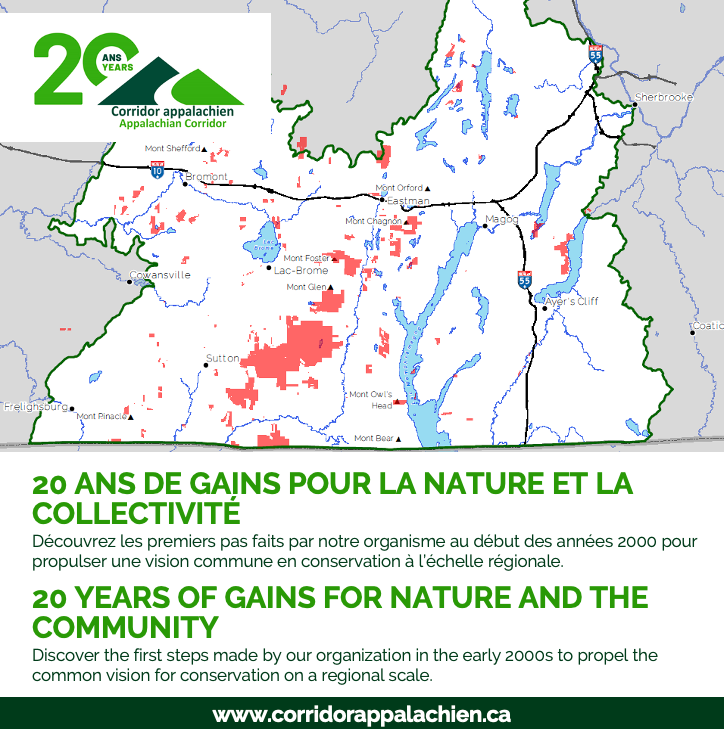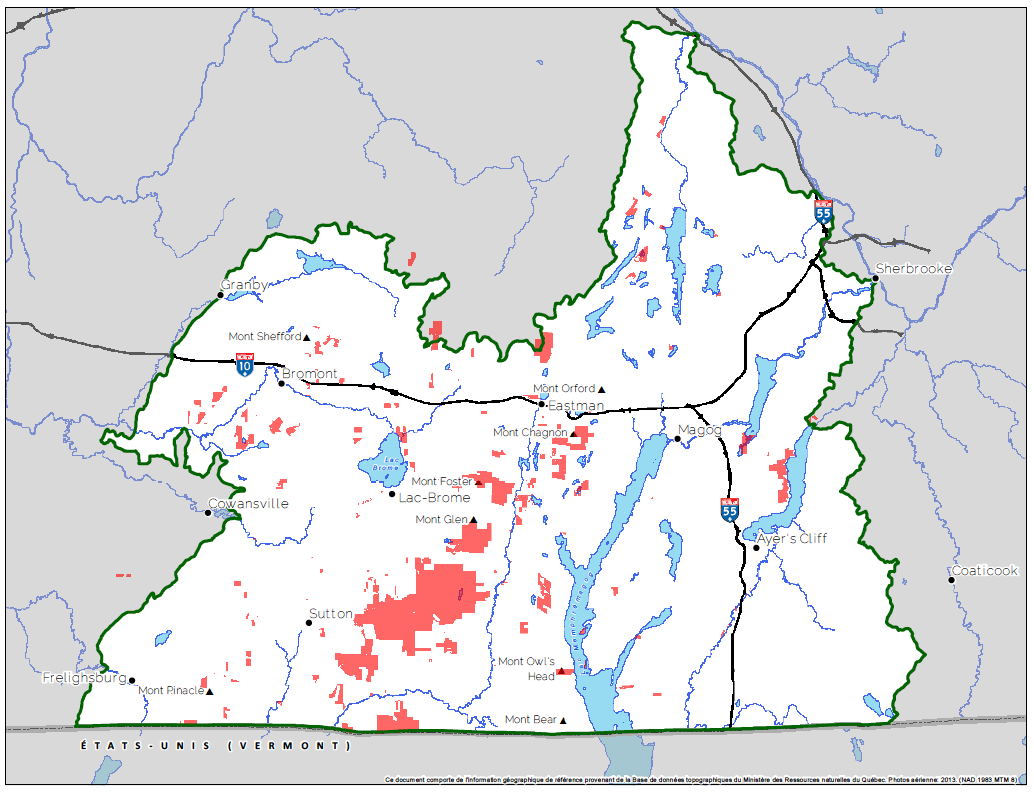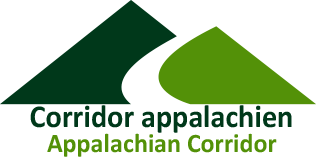
09 May 20 YEARS OF GAINS FOR NATURE AND THE COMMUNITY: APPALACHIAN CORRIDOR’S FIRST STEPS

Appalachian Corridor is a conservation organization dedicated to creating a vast network of protected areas in perpetuity. Founded in 2002, the organization has contributed to the protection of more than 15,500 hectares of land by working closely with the Nature Conservancy of Canada, its 17 affiliate members as well as several funders and donors. On its 20th anniversary, we take the opportunity to look back at the moments, people, and places that have marked two decades of gains for nature and communities.
In this story, Louise Gratton, biologist, and co-founder of Appalachian Corridor, explains the moments that led to the creation of a common vision for the conservation of natural environments on our territory of action.


Left, in red are the perpetually protected private lands on Appalachian Corridor’s territory of action in 2002 and on the right, the gains achieved over 20 years of conservation efforts.
By Louise Gratton, biologist and co-founder of Appalachian Corridor
When minds meet
Initially, the ambitious project to protect a natural corridor extending from the Green Mountains of Vermont to beyond the Parc national du Mont-Orford was fraught with difficulties.
In 2000, Francine Hone, then a consultant for the World Wildlife Fund (WWF) joined me and Terri Monahan, President of the Ruiter Valley Land Trust (RVLT), and the project benefited greatly from our complementary expertise. To promote the corridor project, they agreed to hold an event on October 14, 2000, at the Ruiter Valley Center. Stansje Plantenga graciously provided the venue and all the members of the FFVR board got involved in the logistics.
The program included a tour of targeted conservation properties, a lecture on conservation biology, private stewardship and the Appalachian Corridor project followed by a meal prepared by, among others, the Herman brothers. Present were not only the organizations of the region, the municipalities of the Township of Sutton and the Township of Potton and the WWF, but also the Nature Conservancy of Canada (NCC), the EJLB Foundation, the Canadian Wildlife Service of Environment Canada, the Ministère de la Faune et des Parcs du Québec, the forestry company Domtar Inc. and the Parc Mont-Glen Inc. The Ministère de l’Environnement was absent but the FFVR received a letter of encouragement from the Director of Ecological Heritage, Léopold Gaudreau. The event was a great success but, despite its great potential, the project was politely described as very ambitious because of the lack of knowledge about the endangered fauna and flora of the territory.
We hadn’t shared our last word.
The promotion of Appalachian Corridor
Terri and I continue to meet. In December, the project was presented to the Minister of Canadian Heritage, Sheila Copps, in the company of Denis Paradis, MNA, and another meeting was organized with his brother, Pierre Paradis, then MNA in Brome-Missisquoi. A press release was distributed to the media and lead to interviews on local and national radio.
Nathalie Zinger of the WWF then suggested that the project be submitted to the Kendall Foundation based in Boston. A crucial meeting was organized in early 2001 at the EJLB Foundation offices in Montreal. The Kendall Foundation was represented by none other than Harvey Locke, co-founder of the Yukon to Yellowstone (Y2Y) initiative in Western Canada. The vision of the Wildlands Project is to create a corridor on the east coast of North America, like the one in the Rockies on the west coast. Recognizing its strong scientific basis, the Appalachian Corridor Project is enthusiastically embraced. The two foundations were the first to fund us. The George Cedric Metcalfe Foundation will support us in turn. Harvey Locke admits that the decisive element of his support is the commitment and pragmatism of the two representatives of the FFVR who confide in him that it will take at least 40 years to set up a protected natural corridor in the region.
The project is really taking off
Under the Environmental Priorities Assistance Program, the Ministère de l’Environnement du Québec funds the project. Two factors contributed to this decision: the fact that three private foundations were financially supporting the project and the foresight of the Director of Ecological Heritage, Léopold Gaudreau, who knew the FFVR well.
The following spring, it was a battle of wits. Consultants in botany, herpetology and ornithology travelled through the territory to document the sectors targeted for conservation. In August, the Monts-Sutton region hosted the botanical blitz organized by the Ministère de l’Environnement du Québec and FloraQuebeca. The richness of the territory’s flora and fauna is revealed.
The timing was more than excellent. In the fall of 2001, the Government of Canada launched the Habitat Stewardship Program for Species at Risk – the HSP. The elaborate application for funding includes knowledge acquisition, sectoral conservation strategies, partnership development and, most importantly, the negotiation of conservation agreements. The jury, chaired by Yvon Mercier of Environment Canada’s Canadian Wildlife Service, was impressed by the quality and scope of the project and the support already acquired for its implementation. In fact, in addition to the financial support of several foundations and the Ministère de l’Environnement, an important matching fund has just been set up by the CNC to make the first acquisitions. The financing had been granted. In total, the project the project amounted to nearly $2 million.
In the year that followed, the first ecological gift already in the NCC’s sights, that of Elisabeth and Victor Allistone, became a reality and the acquisition of the Jonhston property and the lands of the Township of Sutton on the Round Top was concluded, the latter with the collaboration of the municipality. Steps were taken to acquire some fifteen other properties, including several on the territories targeted by the FFVR and the Mount Pinnacle Land Trust (MPLT). Several American organizations and partners have also met to share our vision of a cross-border strategy. The links developed were to be very beneficial in the long term.
Given the scope of the project, which had been sponsored by the FFVR, the Board members agreed that it would be preferable to create an organization independent of the Trust, with a much larger territory of action.

De gauche à droite: Francine Hone, Terri Monahan et Louise Gratton.
Photo par Marie-José Auclair.
In December 2002, Appalachian Corridor obtained its non-profit status. A provisional board was formed in October, with Louise Gratton as president, Francine Hone as vice-president and Terri Monahan as secretary. In May 2003, Louise Gratton was replaced as President by Nathalie Zinger, who later became Executive Director of the Nature Conservancy of Canada – Quebec. Terri Monahan retired from the Board of Directors to become the first Executive Director of Appalachian Corridor. That same year, Clément Robidoux joined the team as assistant director and Marie-José Auclair was confirmed on the Board of Directors. Appalachian Corridor was granted charitable status in 2004. Its main objective: “To protect the natural environments and landscapes of the Appalachian region in order to preserve their ecological and aesthetic integrity, for the benefit of local community members and the general public.
NOTES
(1) Private stewardship was eventually replaced by voluntary conservation to refer to the acquisition of private lands by conservation organizations.
(2) Prior to the amalgamation of the Township of Sutton and the Village of Sutton to become the Town of Sutton.
(3) Today’s Wildlands Network.

